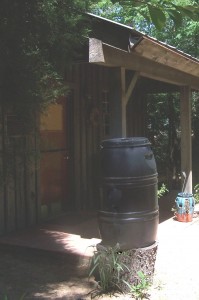Orchids living in trees harvest rain in a clever way. Their v-shaped leaves catch and guide water to the main stem then down to the aerial roots.
You too can mimic nature by capturing rain landing on your garden shed roof with a v-shaped wooden gutter. A slight tilt in one direction guides it toward a rain barrel positioned beneath.
Here’s a rustic example I saw at the North Carolina Botanical Garden 
Note the chunk of tree trunk that lifts up the rain barrel so a watering can or bucket can easily be placed under the drain spigot.
Here are Five Tips when buying a rain barrel:
- 50-75 gallon capacity is reasonable. That’s 50 or more gallons of water you don’t have to pay for.
- Fine gauge bug screen. To keep out mosquitoes, debris and kids.
- Shutoff valve for the hose hook-up and dual overflow (or separate overflow).
- Best if made from renewable and/or recycled materials.
- Consider the character of your site location. (rustic, formal, contemporary)
For example, here’s a handsome rain barrel that fits into many locations and is of good quality and price.
Consider hooking two rain barrels together. It’s surprising how quickly they fill up. It only takes 1/5 of an inch of rain to fill up your barrels!
If you remain concerned about mosquitoes use small portions of mosquito dunks . The active ingredient in them is Bacillus thuringiensis (Bt) kills black fly and mosquito larvae for at least 30 days. It won’t harm you, your plants, or wildlife.
Rain barrels are not meant to be long-term water storage, so plan on using up the water every week. The kids could even wash your car with some rainwater!
Alternately, attach a ‘leaky’ soaker hose (with a cap on the end to block mosquitoes from entering) to the lower hose spigot so it’ll irrigate the surrounding area without you!
“Low pressure” sprinklers can be hooked directly to a rain barrel to water your garden.
Or if you’re feeling mischievous, you could just fill your watering can and ‘sprinkle’ the one you’re with! After finishing a mulching job, they might just thank you for it!

{ 2 comments… read them below or add one }
Is the water safe to use for cooking right out of the barrel or would you recommend some kind of filtration?
Remember you are catching raw water (maybe even acid rain) that is running across roofs and other unsterilized surfaces passing bacteria and microscopic creatures as it goes. It’s great ‘as is’ for virtually everything other than consuming. Otherwise, I’d say you have to ‘treat it’ just like water from a well.